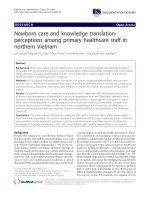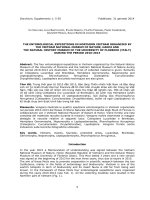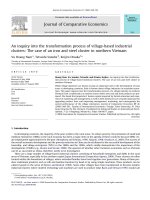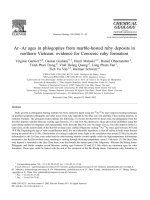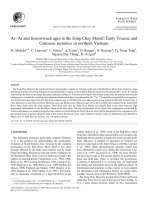The entomological expeditions in northern Vietnam organized by the Vietnam National Museum of Nature, Hanoi and the Natural History Museum of the University of Florence (Italy) during the period 2010-2013
Bạn đang xem bản rút gọn của tài liệu. Xem và tải ngay bản đầy đủ của tài liệu tại đây (7.62 MB, 51 trang )
Onychium, Supplemento 1: 5-55
Pubblicato: 31 gennaio 2014
VU VAN LIEN, LUCA BARTOLOZZI, EYLON ORBACH, FILIPPO FABIANO, FABIO CIANFERONI,
GIUSEPPE MAZZA, SAULO BAMBI & VALERIO SBORDONI
THE ENTOMOLOGICAL EXPEDITIONS IN NORTHERN VIETNAM ORGANIZED BY
THE VIETNAM NATIONAL MUSEUM OF NATURE, HANOI AND
THE NATURAL HISTORY MUSEUM OF THE UNIVERSITY OF FLORENCE (ITALY)
DURING THE PERIOD 2010-2013
Abstract. The four entomological expeditions in Vietnam organized by the Natural History
Museum of the University of Florence and the Vietnam National Museum of Nature during
the period 2010-2013 are illustrated. The full list of collected material is given. Remarks
on Coleoptera Lucanidae and Brentidae, Hemiptera Gerromorpha, Nepomorpha and
Leptopodomorpha,
Rhynchophorus
ferrugineus
(Coleoptera:
Curculionoidea:
Dryophthoridae), Lepidoptera and photo techniques are also given.
Tóm tắt. Trong thời gian từ 2010 đến 2013, Bảo tàng Thiên nhiên Việt Nam và Bảo tàng
Lịch sử Tự nhiên thuộc Đại học Florence đã tổ chức bốn chuyến khảo sát côn trùng tại Việt
Nam. Mẫu vật của một số nhóm cơn trùng được thu thập để nghiên cứu. Một số nhận xét
về bộ cánh cứng Coleoptera (họ Lucanidae và Brentidae), bộ cánh nửa Hemiptera (phân
bộ Gerromorpha, Nepomorpha và Leptopodomorpha), lồi đng dừa Rhynchophorus
ferrugineus (Coleoptera: Curculionoidea: Dryophthoridae), bướm và ngài (Lepidoptera) và
kỹ thuật chụp ảnh được trình bày trong bài báo.
Riassunto. Vengono illustrate le quattro spedizioni entomologiche in Vietnam organizzate
nel periodo 2010-2013 dal Museo di Storia Naturale dell’Università degli Studi di Firenze in
collaborazione con il Vietnam National Museum of Nature di Hanoi. Viene fornita una lista
completa del materiale raccolto durante le missioni. Vengono inoltre esaminate in maggior
dettaglio le raccolte relative ai seguenti taxa: Coleoptera Lucanidae e Brentidae,
Hemiptera Gerromorpha, Nepomorpha e Leptopodomorpha, Rhynchophorus ferrugineus
(Coleoptera: Curculionoidea: Dryophthoridae), Lepidoptera. Vengono fornite anche
indicazioni sulle tecniche fotografiche utilizzate.
Key words. Vietnam, insects, faunistic, protected areas, Lucanidae,
Gerromorpha, Nepomorpha, Leptopodomorpha, Rhynchophorus ferrugineus.
Brentidae,
Introduction
In the year 2010 a Memorandum of Understanding was signed between the Vietnam
National Museum of Nature, Hanoi (Socialist Republic of Vietnam) and the Natural History
Museum of the University of Florence (Italy). This MoU lasted 3 years and a new version
was signed at the beginning of 2013 for the next three years, thus due to expire in 2015.
The aim of these MoUs was to promote cooperation in scientific research between the two
Institutions, mainly in the fields of entomology and biodiversity. Vietnam is one of the
world’s hotspots in term of biodiversity and its insect fauna is still far from being well
known. In the framework of these MoUs four entomological expeditions were organized
during the years 2010-2013 (see Tab. 1). All the collecting localities were located in the
Northern part of Vietnam (Fig. 1).
5
date
4-23.VI.2010
20.V-12.VI.2011
11-27.VI.2012
31.V-16.VI.2013
members of the expedition
Vu Van Lien, Luca Bartolozzi,
Saulo Bambi, Lorenzo Benini
Vu Van Lien, Luca Bartolozzi,
Eylon Orbach, Saulo Bambi,
Filippo Fabiano
Vu Van Lien, Luca Bartolozzi,
Eylon Orbach, Saulo Bambi,
Filippo Fabiano
Vu Van Lien, Luca Bartolozzi,
Eylon Orbach, Saulo Bambi,
Fabio Cianferoni, Giuseppe
Mazza, Valerio Sbordoni
collecting localities
Tam Dao National Park, Xuan Son
National Park
Van Ban Nature Reserve, Hoang
Lien National Park, Ba Be National
Park
Phia Oac Nature Reserve, Tam
Dao National Park, Xuan Son
National Park, Ba Vi National Park
Tam Dao National Park, Na Hang
Nature Reserve, Hang Kia - Pa Co
Nature Reserve
Tab. 1. Collecting sites and staff members of the expeditions to N-Vietnam (2010-2013).
Fig. 1. Collecting sites. 1. Ba Be National Park; 2. Ba Vi National Park; 3. Hoang Lien
National Park; 4. Tam Dao National Park; 5. Xuan Son National Park; 6. Na Hang Nature
Reserve; 7. Hang Kia - Pa Co Nature Reserve; 8. Phia Oac Nature Reserve; 9. Van Ban
Nature Reserve.
Collecting sites
Ba Be National Park (Fig. 2)
This park is located in the Bac Kan Province and was established in 1992. It covers a
surface of about 100 square kilometers around the Ba Be Lake. The lake is surrounded by
limestone hills, reaching over 1500 m a.s.l., covered by evergreen forests. We collected
around the Park Headquarter, at about 350 m a.s.l.
6
Fig. 2. Ba Be National Park (photo S. Bambi).
Fig. 3. Ba Vi National Park (photo S. Bambi).
7
Fig. 4. Hoang Lien National Park (photo S. Bambi).
Fig. 5. Tam Dao National Park (photo S. Bambi).
8
Fig. 6. Xuan Son National Park (photo S. Bambi).
Ba Vi National Park (Fig. 3)
This park is located in the Ha Noi Province, about 50 kilometers west of Hanoi and was a
French hill station during the colonial period. The national park was established in 1991,
with a surface area of about 114 square kilometers. It is an isolated limestone and soil
mountain covered with forest. We collected around the Ba Vi Guest House at about 400 m
a.s.l. and areas of 600-800 m a.s.l. and at Vua Peak (1290 m a.s.l.).
Hoang Lien National Park (Fig. 4)
This park is situated in two provinces, Lao Cai and Lai Chau, and contains the largest
range of mountains in the north of Vietnam, of varying altitudes. The National Park was
established in 2006 and covers a surface of about 300 square kilometers. The highest peak
is Fansipan (3143 m a.s.l.), which is also the highest mountain in Vietnam. We mainly
collected in the surroundings of the Sa Pa pass (about 1900 m a.s.l.) and Cat Cat village
(about 1250-1350 m a.s.l.) in the Lao Cai Province.
Tam Dao National Park (Fig. 5)
This well known national park, established in 1996, is located in the Vinh Phuc Province, on
a mountain range (maximum elevation 1592 m a.s.l.) rich in endemic species. The slopes
of the mountain are covered with natural forest for about 220 square kilometers. This park
was visited several times by our expeditions over different years and most of the collecting
was done along a path starting from the small town of Tam Dao, around 950 m a.s.l.
Xuan Son National Park (Fig. 6)
This park, established in 2002, is located in the Phu Tho Province, and it covers an area of
mountains and forests of about 150 square kilometers. This park was visited twice by our
expeditions and most of the collecting was done around the small village of Xom Du, at an
altitude of about 500 m a.s.l.
9
Fig. 7. Na Hang Nature Reserve (photo S. Bambi).
Fig. 8. Hang Kia - Pa Co Nature Reserve (photo F. Cianferoni).
10
Fig. 9. Phia Oac Nature Reserve (photo S. Bambi).
Fig. 10. Van Ban Nature Reserve (photo S. Bambi).
11
Na Hang Nature Reserve (Fig. 7)
The reserve, established in 1994, is located in the Tuyen Quang Province and covers an
area of about 220 square kilometers. The landscape is composed of limestone hills and
mountains and the majority of the area is located at 300-800 m a.s.l., with the highest
peak reaching 1067 m a.s.l. We collected inside the forest near the dam, at about 150 m
a.s.l.
Hang Kia - Pa Co Nature Reserve (Fig. 8)
This reserve is located in the Hoa Binh province and extends for around 70 square
kilometers. The site is a limestone range which reaches 1500 m a.s.l. in the north western
part of the area and decreases in altitude eastwards. We collected in several spots not far
from the head quarters of the reserve, at an altitude varying from 700 to 1200 m a.s.l.
Phia Oac Nature Reserve (Fig. 9)
The reserve was established in 1986, is located in the Cao Bang province and extends for
about 100 square kilometers. The area is covered by primary and secondary forest; the
reserve reaches 1900 m a.s.l. We collected along the road to the peak of Phia Oac (1900
m) and near the salmon rearing farm (about 800-1000 m a.s.l.).
Van Ban Nature Reserve (Fig. 10)
This reserve was established in 2007 and is located in the Lao Cai Province, not far from
the Hoang Lien National Park. The reserve has a surface of about 256 square kilometers;
the area is covered by primary and secondary forests reaching up about 2000 m a.s.l. We
collected along a trail inside a secondary forest at an altitude of about 1000 m a.s.l.
The authors of the present contribution took part in some, if not all, the expeditions, each
one as specialist of a different group of Hexapoda; one of us (SB), being the photographer
of the Natural History Museum of Florence, had the duty of documenting the different
aspects of the trips and taking close-up pictures of the most interesting insects.
We believe it useful to list (Tab. 2) the material collected during the four expeditions to
northern Vietnam (2010-2013) because only a relatively small part of it has already been
studied (e.g. Coleoptera Brentidae, Cerambycidae, Hybosoridae, Staphylinidae
Aleocharinae, Staphylinidae Xantholininae, Lucanidae, Cetoniidae, Cicindelidae, Dytiscidae,
Eulichadidae, Elmidae, Dryopidae, Histeridae, Trogidae; Hymenoptera Formicidae,
Tiphiidae;
Diptera
Phoridae;
Hemiptera
Gerromorpha,
Nepomorpha
and
Leptopodomorpha; Phasmida; Lepidoptera).
We shall be glad to send specimens on loan for identification to specialists who request
material of other families for scientific research.
taxa
COLEOPTERA
Aderidae
Anobiidae
Anthicidae
Anthribidae
Apionidae
Aphodiidae
Attelabidae
Bostrichidae
Brentidae
Buprestidae
Cantharidae
Carabidae
2010
2011
2012
2013
1
6
1
67
60
10
3
11
16
13
55
3
8
41
1
142
56
5
27
13
114
143
19
12
16
3
7
19
6
14
39
1
13
7
13
16
6
17
16
18
58
12
Cerambycidae
Ceratocanthidae
Cetoniidae
Chelonaridae
Chryptophagidae
Chrysomelidae
Cicindelidae
Ciidae
Cleridae
Coccinellidae
Colydiidae
Cucujidae
Curculionidae
Cybocephalidae
Dascillidae
Dermestidae
Dryopidae
Dynastidae
Dytiscidae
Elateridae
Elmidae
Endomychidae
Erotylidae
Euchiridae
Eulichadidae
Georyssidae
Gyrinidae
Haliplidae
Helophoridae
Heteroceridae
Histeridae
Hybosoridae
Hydrophylidae s.l.
Lampyridae
Languridae
Lathrididae
Leiodidae
Limnichidae
Lucanidae
Lycidae
Lymexilionidae
Malachidae
Meloidae
Melolonthidae
Melyridae
Mordellidae
Nitidulidae
Noteridae
Oedemeridae
Ostomidae
Passalidae
Pedilidae
Platypodidae
Pselaphidae
Psephenidae
98
10
9
2
174
72
40
9
19
128
1
2
2
19
62
204
57
3
2
24
1
1
1
32
3
40
60
5
8
2
68
20
5
6
22
204
7
36
3
1
9
10
20
7
-
617
2
13
10
341
43
2
20
73
8
7
334
2
62
8
124
224
12
15
9
3
21
13
16
5
97
2
25
102
15
29
1
3
1
25
7
2
17
256
2
31
7
9
32
1
17
19
3
13
163
14
142
62
31
59
2
1
80
6
12
14
45
162
2
2
11
4
5
44
32
4
27
1
23
4
9
4
90
1
11
1
13
7
1
1
150
5
14
258
165
33
51
1
207
5
6
8
195
2
8
5
1
101
20
14
44
26
17
2
5
3
16
12
7
11
5
3
4
9
6
4
Ptilodactylidae
Ptiniidae
Pyrochroidae
Rhipiceridae
Rutelidae
Scaphididae
Scarabaeidae
Scolytidae
Silphidae
Sphaeridiidae
Staphylinidae
Tenebrionidae
Thorictidae
Trichidae
Trictenotomidae
Trogidae
DIPTERA
Agromyzidae
Anthomyzidae
Asilidae
Athericidae
Bibionidae
Bolitophilidae
Bombyliidae
Calliphoridae
Cecidomyiidae
Celyphidae
Ceratopogonidae
Chloropidae
Clusiidae
Cryptochetidae
Culicidae
Diopside
Dolichopodiidae
Drosophilidae
Empididae
Ephydridae
Hybotidae
Keroplatidae
Lauxaniidae
Limoniidae
Lonchaeidae
Megamerinidae
Micropezidae
Milichiidae
Muscidae
Neriidae
Nothibidae
Oestridae
Pipunculidae
Platystomatidae
Pseudopomyzidae
Psychodidae
Pyrgotidae
Rhagionidae
147
62
38
44
3
1
1
10
1
8
271
10
23
10
12
130
217
3
1
3
1
3
93
4
37
3
1
70
27
11
-
5
1
1
63
1
34
13
60
75
4
1
5
3
23
1
2
2
3
26
50
3
1
1
34
22
2
2
8
1
6
22
17
16
3
1
1
1
5
7
1
1
15
1
26
1
4
21
37
62
7
6
2
4
2
1
2
295
1
1
6
2
2
1
11
1
1
2
-
18
1
1
4
4
3
4
5
1
4
2
2
3
9
1
3
2
6
14
Sarcophagidae
Scatopsidae
Sciaridae
Sepsidae
Simuliidae
Sphaeroceridae
Stratiomyiidae
Strongylophtalmyiidae
Syrphidae
Tabanidae
Tachinidae
Tanypezidae
Tephritidae
Tipulidae
Ulidiidae
Xylomyiidae
HEMIPTERA
HETEROPTERA
Alydidae
Anthocoridae
Aradidae
Belostomatidae
Coreidae
Corixidae
Cydnidae
Dinidoridae
Dipsocoridae
Gelastocoridae
Gerridae
Hebridae
Helotrephidae
Hydrometridae
Largidae
Lygaeidae
Mesoveliidae
Micronectidae
Miridae
Nabidae
Naucoridae
Nepidae
Notonectidae
Ochteridae
Pentatomidae
Plataspidae
Pleidae
Pyrrhocoridae
Reduviidae
Rhopalidae
Saldidae
Scutelleridae
Tesseratomidae
Urostylidae
Veliidae
CICADOMORPHA
Aphrophoridae
1
22
11
5
49
8
2
20
32
11
3
2
1
-
85
15
306
12
47
14
15
1
6
1
2
4
6
10
4
-
3
8
2
21
12
16
7
10
6
-
1
2
5
4
5
19
1
12
1
18
1
11
2
5
9
1
15
1
1
13
17
10
48
8
4
12
5
7
4
5
2
1
6
28
6
2
4
12
5
2
4
2
1
14
8
1
143
3
1
14
3
2
1
6
1
1
6
1
2
3
143
5
8
12
10
17
1
68
236
12
7
8
20
4
7
16
1
2
9
5
20
3
11
12
2
3
236
-
2
1
1
15
Cercopidae
Cicadellidae
Cicadiidae
Membracidae
FULGOROMORPHA
Ciixidae
Delphacidae
Dictyopharidae
Eurybrachidae
Flatidae
Fulgoridae
Issidae
Nogodinidae
Ricaniidae
Tropiduchidae
HYMENOPTERA
Apoidea
Braconidae
Chrysididae
Eumenidae
Evanidae
Formicidae
Ichneumonidae
Mutillidae
Platygasteridae
Pompilidae
Scoliidae
Sphaecidae
Tiphiidae
Vespidae
LEPIDOPTERA
Papilionidae
Pieridae
Nymphalidae
Lycaenidae
Hesperiidae
Saturniidae
Brahmaeidae
Sphingidae
Other families
ODONATA
ZYGOPTERA
Amphipterygidae
Caliphaeidae
Chlorocyphidae
Calopterygidae
Euphaeidae
Lestidae
Coenagrionidae
Platycnemidae
Platystictidae
Protoneuridae
ANISOPTERA
Aeshnidae
Gomphidae
7
25
14
3
21
23
21
4
3
6
7
2
10
23
13
5
1
1
1
1
3
1
1
2
6
4
-
1
1
1
3
-
4
1
1
1
1
4
-
1
4
267
15
17
10
9
11
3
19
9
5
1
1
4
321
29
5
11
1
4
3
-
4
1
1
1
159
20
1
1
2
11
11
14
11
1
4
189
40
4
6
5
2
14
50
60
200
80
40
15
3
6
15
83
136
373
149
59
65
3
95
1331
75
84
316
131
55
34
11
143
707
60
70
140
110
30
19
3
12
6
1
5
2
13
1
3
15
1
2
8
2
10
-
1
1
4
1
7
1
7
8
1
-
4
5
4
19
3
-
1
-
2
1
2
16
Cordulegastridae
Chlorogomphidae
Corduliidae
Libellulidae
2
48
1
25
1
4
30
3
22
BLATTODEA
COLLEMBOLA
DERMAPTERA
ISOPTERA
MANTODEA
MECOPTERA
NEUROPTERA
ORTHOPTERA
PHASMIDA
PLECOPTERA
PSOCOPTERA
THYSANOPTERA
THYSANURA
TRICHOPTERA
35
1
15
1
28
1
30
17
6
1
-
30
44
22
6
30
9
4
1
12
1
1
1
32
30
2
31
11
5
-
11
1
15
33
25
9
14
25
21
1
3
3
2
Tab. 2. Insects collected in northern Vietnam during the four expeditions.
Materials and methods
Different collecting methods were used: the daytime collecting was done using sweeping
nets, butterfly nets, beating trays, hand picking on trunks, leaves, flowers, under stones
and barks (Fig. 11), or sifting the forest litter (Fig. 12).
Fig. 11. Collecting insects on barks, Tam Dao National Park (photo S. Bambi).
17
Fig. 12. Forest litter sifting, Van Ban Nature Reserve (photo S. Bambi).
Fig. 13. Malaise trap, Ba Be Nature Reserve (photo S. Bambi).
18
In some localities Malaise traps (Fig. 13) were placed; in a few cases pitfall traps were also
used. At night a generator was used to feed a bulb of 200 W in a light trap with four
sectors (Fig. 14). The collected material was preserved in plastic bottles with cork saw
dust and ethyl acetate or in 70% alcohol, apart from a few samples in pure alcohol for
DNA analysis.
During the expeditions special emphasis was placed on investigating several groups of
insects, due to the presence of specialists and taxonomists among the members of the
staff. We believe it useful to provide general remarks and a few interesting observations
on some of the studied groups here.
Fig. 14. Light trap, Tam Dao National Park (photo S. Bambi).
Research on stag beetles (Coleoptera Lucanidae)
The present count of this family of Scarabaeoidea is 118 genera and about 1750 species
worldwide. The main characteristics of the Lucanidae are the geniculate antenna, with the
segments of antennal club fixed and not capable of being tightly closed together, and the
strong sexual dimorphism and allometry which are present throughout most of the
species. The size can vary from less than one to more than ten centimeters.
Vietnam is particularly rich in stag beetles: around 180 species, belonging to about 25
genera, are quoted for the country to date. The endemism rate is rather high, due to the
presence of a large amount of habitats and different climate ranges from South to North;
the presence of isolated mountains has also been an important factor for speciation.
During the last years many papers dealing with the Lucanidae of Vietnam have been
published, and many new species have been described (NAGAI, 1996; IKEDA 1997a, 1997b,
1997c, 2000a, 2000b; BABA, 2000; ZILIOLI, 1998; SUZUKI, 2001; DANG & TRAN, 2003;
ARNAUD & MIYASHITA, 2006; FUJITA, 2009, 2010; KATSURA & GIANG, 2002; MAEDA, 2009,
2010, 2012; NAGAI & MAEDA, 2010; OKUDA, 2009a, 2009b, 2012; SCHENK, 2012, 2013a,
2013b; QUANG THAI, 2013; QUANGTHAI & SCHENK, 2013).
19
Stag beetle collecting in equatorial and tropical countries is mainly done at night, with the
use of a light trap, as most of the lucanid species are nocturnal. The Lucanidae fauna of
Northern Vietnam has several species in common with Southern China, whilst the fauna in
the South becomes more typically tropical. For instance, in the North we collected several
species of the Palaearctic genus Lucanus Scopoli, 1763, such as Lucanus planeti Planet,
1899 (Fig. 15) and L. kraatzi giangae Ikeda, 1997 in Phia Oac Nature Reserve, and L.
nobilis Didier, 1925 in Hoang Lien National Park. In Phia Oac Nature Reserve we collected
at light several specimens of one of the largest stag beetles inhabiting Vietnam,
Odontolabis cuvera Hope, 1842. In the genus Odontolabis Hope, 1842 sexual dimorphism
is very high, as is the allometry in males. The small males have small mandibles and are
more similar to females (Fig. 16), whilst large males show impressive large and strong
mandibles (Fig. 17). In Tam Dao National Park we collected another very large species,
Prosopocoilus confucius (Hope, 1842); in this species the large males (Fig.18) have
mandibles which are longer and more slender than in Odontolabis cuvera.
In general stag beetles do not fly during the day, but in Tam Dao National Park we
observed a large male of Odontolabis cuvera flying at noon during a sunny day. During the
day it is possible to find some specimens of Lucanidae in dead wood or walking on trunks
or on the ground; e.g. in Xuan Son National Park two specimens of Nigidionus parryi
(Bates, 1866) were found inside a decaying standing tree; in Tam Dao National Park some
males of Neolucanus opacus Boileau, 1899 (Fig. 19) were found on the trunk of a living
tree. In the genera Figulus Macleay, 1819 and Nigidius Macleay, 1819 sexual dimorphism
is absent; in specimens belonging to those genera the sex can be recognized only
dissecting the genitalia, as the external morphology is the same in males and females.
Generally Vietnamese stag beetles are black or dark brown, like Neolucanus opacus or
Dorcus antaeus Hope, 1842 (Fig. 20), but there are also colored species, like for instance
Prosopocoilus suturalis (Olivier, 1789) (Fig. 21) and Rhaetulus speciosus kawanoi Maes,
1996 (Fig. 22) [Note: Fujita (2010) illustrated this species under the name R. crenatus
kawanoi].
Fig. 15. Lucanus planeti Planet, 1899 male, Phia Oac Nature Reserve (photo S. Bambi).
20
Fig. 16. Odontolabis cuvera Hope, 1842 small male, Phia Oac Nature Reserve (photo S.
Bambi).
Fig. 17. Odontolabis cuvera Hope, 1842 large male, Phia Oac Nature Reserve (photo S.
Bambi).
21
Fig. 18. Prosopocoilus confucius (Hope, 1842) male, Tam Dao National Park (photo S.
Bambi).
Fig. 19. Neolucanus opacus Boileau, 1899 male, Tam Dao National Park (photo S. Bambi).
22
Fig. 20. Dorcus antaeus Hope, 1842 male, Phia Oac Nature Reserve (photo S. Bambi).
Fig. 21. Prosopocoilus suturalis (Olivier, 1789) small male, Na Hang Nature Reserve (photo
S. Bambi).
23
Fig. 22. Rhaetulus speciosus kawanoi Maes, 1996 large male, Tam Dao National Park
(photo S. Bambi).
The family Lucanidae, consisting of species which are saproxylic at the larval stage, is
particularly important for the ecology of the forests and in Europe several species have
been included in protection laws (e.g. Lucanus cervus Linnaeus, 1758).
Research on Coleoptera Brentidae
Brentidae is a beetle family belonging to the superfamily Curculionoidea, counting 296
genera and 1760 species worldwide. Most of the species are uncommon, occasionally
found on recently dead or dying trees and tree stumps, or attracted to light at night. The
last comprehensive study of the Brentidae of Vietnam was made by KABAKOV (2001), who
intensively collected in North Vietnam between 1961 to 1964. Kabakov listed 123 species
of Brentidae, after studying more than 3500 specimens, about half of which he collected
himself. According to this author, brentids seem to be more abundant in relatively recently
cut areas and fire sites. Further studies by different authors (MANTILLERI, 2005, 2007;
GOOSSENS, 2008) increased the species number for Vietnam to 147.
Our four expeditions made in North Vietnam concentrated in areas covered by primary or
secondary forests within natural reserves and national parks. Four methods were used for
collecting Brentidae: hand picking, using a beating tray, dragging a net under branches
and trunks of fallen trees and using a light trap at night.
For the light trap we used a mercury vapor bulb and a white sheet. This is a very good
method which usually yields the largest amount of specimens and species, since most
Brentidae are attracted to light and are rarely encountered during the day. In nearly all of
the collecting sites Brentids were collected when the temperature was not too cold and the
wind speed was not too high. In Na Hang Nature Reserve we collected for instance large
specimens of Hormocerus reticulatus (Lund, 1800) (Fig. 23).
24
Fig. 23. Hormocerus reticulatus (Lund, 1800), Na Hang Nature Reserve (photo S. Bambi).
Fig. 24. Fallen tree where several brentid species were collected at Ba Be National Park
(photo S. Bambi).
25
Fig. 25. Ceocephalus articulatus (Senna, 1911), male and female, Xuan Son National Park
(photo S. Bambi).
Fig. 26. Use of beating sheet at Hang Kia - Pa Co Nature Reserve (photo S. Bambi).
26
Fig. 27. Hypomiolispa sp., Hang Kia - Pa Co Nature Reserve (photo S. Bambi).
Dragging a net under trunk of fallen trees was most successful in Ba Be National Park,
where a freshly fallen tree was found adjacent to the road about 300 meters from the park
headquarters (Fig. 24). Most species collected on the trunk and branches of this tree were
Cyphagogus Parry, 1849 (13 specimens) and Calodromus mellyi Guérin-Méneville & Gory,
1832 (3 specimens).
Hand picking was more rarely used in the field, since a very thorough eye search is
needed, requiring a lot of concentration, time and energy. However, in Xuan Son National
Park, walking at night in the forest and inspecting the trunk of a dying, still standing tree
with a torch, we found a mating pair of one of the largest (male reaching 65 mm in length)
and most impressive brentid species inhabiting Vietnam, Ceocephalus articulatus (Senna,
1911) (Fig.25). Several more visits to the tree over the following days yielded three more
specimens of the same species, in addition to a pair of Ceocephalus antennatus (Ritsema,
1882).
A beating sheet was only used in the fourth expedition (Fig. 26), and a few specimens of a
species of Hypomiolispa Kleine, 1918 (Fig. 27) were collected in Hang Kia - Pa Co Nature
Reserve. Further use of this method in future collecting trips will certainly increase the
amount of Brentidae collected.
Research on butterflies and moths (Lepidoptera)
The butterfly fauna of Vietnam is relatively well known. A checklist of the butterflies
(MONASTYRSKII & DEVYATKIN, 2003) as well as part of a series of books dealing with the
Rhopalocera families have been published so far (MONASTYRSKII, 2005, 2007, 2011). The
biogeography of the butterfly fauna has been analysed by MONASTYRSKII & HOLLOWAY
(2013).
Lepidoptera were extensively collected during the four expeditions. The total number of
specimens collected amounts to about 4760 of which about 2301 are butterflies and 2459
moths. Some interesting species are illustrated (Figs 28-35).
27
Fig. 28. Cigaritis syama latipicta (Fruhstorfer, 1912) (family Lycaenidae), Ba Vi National
Park (photo Vu Van Lien).
Fig. 29. Stichophthalma howqua tonkiniana Fruhstorfer, 1901 (family Nymphalidae), Tam
Dao National Park (photo Vu Van Lien).
28
Fig. 30. Zeltus amasa (Hewitson, 1865) (family Lycaenidae), Na Hang Nature Reserve
(photo S. Bambi).
Fig. 31. Tarsolepis brunnea Cai, 1985 (family Notodontidae) with scent pencils organs
extended, Hoang Lien National Park (photo S. Bambi).
29

